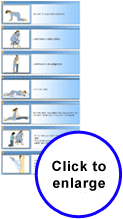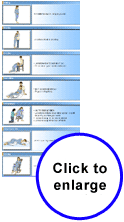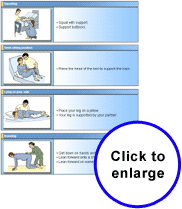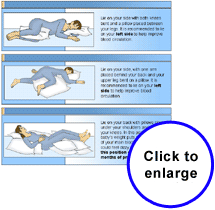MODULE 7
Healthy Birthing
3. Pant-Blow Breathing
This breathing technique will help you to relax when your contractions are longer and stronger and you can no longer relax using the other breathing techniques. This technique is also referred to as transition breathing.
Pant-blow breathing is done through the mouth. You take several fast, shallow breaths and then you blow out
The shallow breaths make a quiet "heh" sound. Choose any rhythm that is best for you. Many women are comfortable with "heh, heh, heh, heh, and blow" (four fast pants to one complete blow). You can also try other rhythms like "heh, heh, blow" (two fast pants to one complete blow) or "heh, heh, heh, blow" (three fast pants to one complete blow). Try them all in order to choose the one that is best for you.
 for a description of the pant-blow breathing technique.
for a description of the pant-blow breathing technique.
 to hear the pant-blow breathing technique.
to hear the pant-blow breathing technique.
This type of breathing is used during the transition phase that happens towards the end of the first stage. At this point, contractions can last for about 90 seconds and can be very close together
Practice until you can stay relaxed and comfortable for 90 seconds while doing pant-blow breathing.
2. Faster Shallow Breathing
This is the breathing technique you can use if your contractions become more intense, and you have difficulty relaxing using the slow deep breathing technique. Faster, shallow breathing is done more quickly and higher in your chest.
 for a description of the faster, shallow breathing technique.
for a description of the faster, shallow breathing technique.
 to hear the "faster shallow breathing" technique.
to hear the "faster shallow breathing" technique.
To practice the faster, shallow breathing technique, begin by taking short rapid breaths. Each breath should be light and shallow.
Try breathing at different speeds until you find one that is comfortable for you. Practice this breathing until you can stay relaxed and comfortable for 60 to 90 seconds.
1. Slow Deep Breathing
Your normal breathing may be slower or faster than another person. Begin by relaxing and breathing so that you are comfortable.
Most women begin with slow deep breathing and continue as long as they feel comfortable.
 for a description of the slow deep breathing technique.
for a description of the slow deep breathing technique.
 to hear the slow deep breathing technique.
to hear the slow deep breathing technique.
To practice this breathing technique, you or your partner can place a hand on your belly or your chest. You will notice that your chest rises and falls with each breath. Your partner can check that your arms and shoulders remain relaxed.
f. Back Pain
Most women feel contractions in their lower abdomen, but about one in four women will feel them in their back. The back pain is caused by the baby's back pressing against your back. This back pain is usually felt just under your waist and lasts for most of the first stage of labour.
The following advice will help alleviate back pain during labour.
The birthing ball can be very useful if you feel contractions in your lower back. You can lean on it when you are on your hands and knees.
This is how to use the birthing ball to alleviate lower back pain.
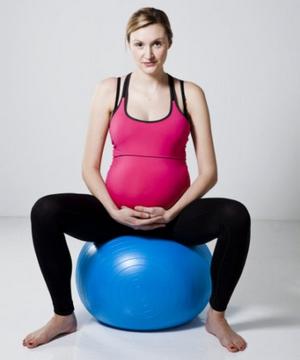 |
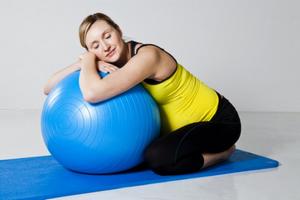 |
This position encourages movement of the pelvis and the hips and uses gravity to help the baby rotate which will be less painful for you.
g. Breathing
Breathing is natural and most of the time, we don't even think about it. However, during delivery, the way you breathe can make a real difference. Learning to pace your breathing can help you relax during your labour. Your breathing can make your contractions more effective.
Choose the breathing technique that is best for you. Labour is different for each woman. Look at breathing techniques and rhythm as tools to help you during your labour.
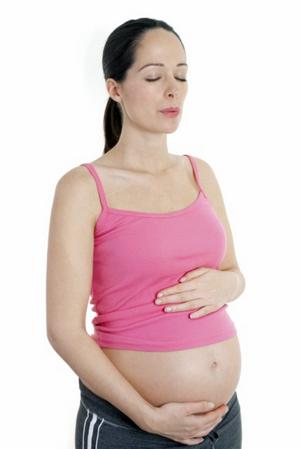
Test Your Knowledge
|
|
The following exercise will help you learn more about the measures that provide a comfort during labour and delivery.
Click on the option button which corresponds to the correct answer and verify your answer by clicking on the "Check" button.
|
1 |
Among the following options, which is the most appropriate to help the mother relax? |
|
2 |
How can hydrotherapy be useful during labour and delivery? |
|
3 |
Among the following measures, which one is the most appropriate during labour and delivery? |
|
4 |
What could you do to replace the lost fluids, maintain your level of energy, and quench your thirst? |
|
5 |
What could you do to focus your attention during your contractions? |
|
6 |
Which among the following items could be useful during labour and delivery? |
e. Comfort Measures
Breathing, relaxation, finding comfortable positions, and massage will all help you feel better during labour.
Remember that labour is different for each woman. There are no good or bad techniques; only techniques that are more or less effective. Try different ones to find what works best for you.
c. Positions
It is a good idea to practice all the possible positions that you might find comfortable during your labour. Practice them until they become comfortable.
Here are a few important points to remember.
The following table demonstrates a few positions to try during the first stage of labour.
The following table demonstrates a few positions to try during the second stage of labour - pushing.
b. Relaxation
Learning to relax is one of the best ways to work with your contractions during labour. You will find the detailed instructions in Module 6 entitled "Healthy Activity".
Since you never know what will feel good during labour, it is a good idea to practice relaxing in many different positions. Here are a few examples of relaxation positions.
Remember, however, that there is one relaxation position that you should avoid. Do not lie flat on your back after your 16th week of pregnancy. This is because the weight of your uterus presses on your blood vessels and can reduce blood flow to you and your baby.
3. Third Stage
The third stage, which takes about 5 to 30 minutes, involves the expulsion of the placenta. The placenta that fed your baby in the uterus comes out in the same way as the baby.


